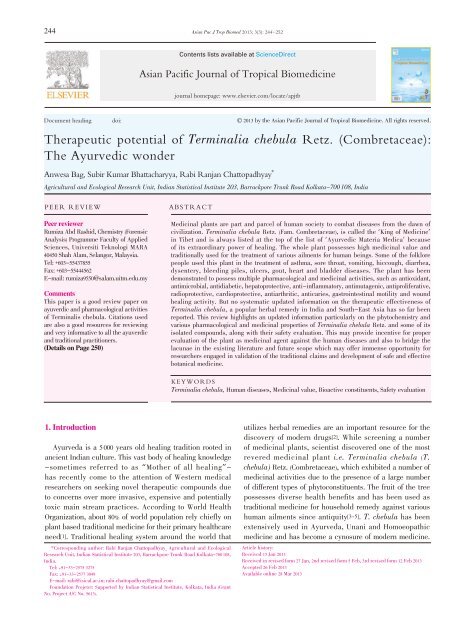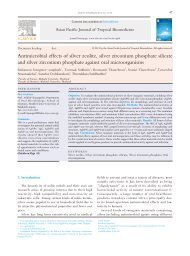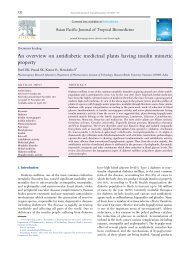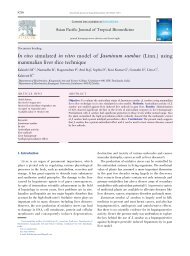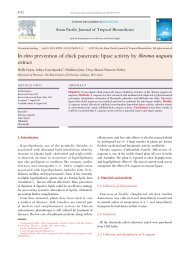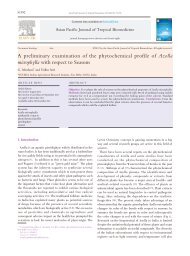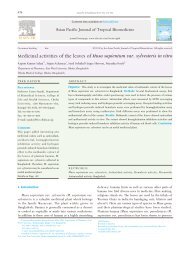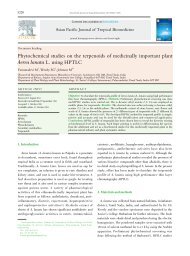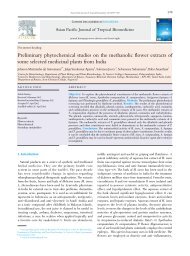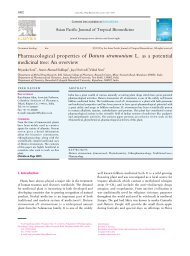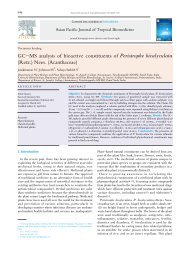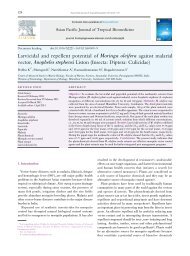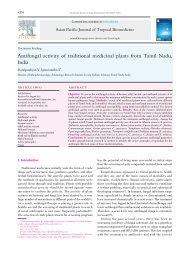Therapeutic potential of Terminalia chebula Retz ... - Apjtb.com
Therapeutic potential of Terminalia chebula Retz ... - Apjtb.com
Therapeutic potential of Terminalia chebula Retz ... - Apjtb.com
You also want an ePaper? Increase the reach of your titles
YUMPU automatically turns print PDFs into web optimized ePapers that Google loves.
244<br />
Asian Pac J Trop Biomed 2013; 3(3): 244-252<br />
Asian Pacific Journal <strong>of</strong> Tropical Biomedicine<br />
journal homepage: www.elsevier.<strong>com</strong>/locate/apjtb<br />
Document heading doi: 襃 2013 by the Asian Pacific Journal <strong>of</strong> Tropical Biomedicine. All rights reserved.<br />
<strong>Therapeutic</strong> <strong>potential</strong> <strong>of</strong> <strong>Terminalia</strong> <strong>chebula</strong> <strong>Retz</strong>. (Combretaceae):<br />
The Ayurvedic wonder<br />
Anwesa Bag, Subir Kumar Bhattacharyya, Rabi Ranjan Chattopadhyay *<br />
Agricultural and Ecological Research Unit, Indian Statistical Institute 203, Barrackpore Trunk Road Kolkata-700 108, India<br />
PEER REVIEW ABSTRACT<br />
Peer reviewer<br />
Rumiza Abd Rashid, Chemistry (Forensic<br />
Analysis) Programme Faculty <strong>of</strong> Applied<br />
Sciences, Universiti Teknologi MARA<br />
40450 Shah Alam, Selangor, Malaysia.<br />
Tel: +603-55437855<br />
Fax: +603-55444562<br />
E-mail: rumiza9550@salam.uitm.edu.my<br />
Comments<br />
This paper is a good review paper on<br />
ayuverdic and pharmacological activities<br />
<strong>of</strong> Terminalis <strong>chebula</strong>. Citations used<br />
are also a good resources for reviewing<br />
and very informative to all the ayuverdic<br />
and traditional practitioners.<br />
(Details on Page 250)<br />
1. Introduction<br />
Ayurveda is a 5 000 years old healing tradition rooted in<br />
ancient Indian culture. This vast body <strong>of</strong> healing knowledge<br />
-sometimes referred to as “Mother <strong>of</strong> all healing”-<br />
has recently <strong>com</strong>e to the attention <strong>of</strong> Western medical<br />
researchers on seeking novel therapeutic <strong>com</strong>pounds due<br />
to concerns over more invasive, expensive and <strong>potential</strong>ly<br />
toxic main stream practices. According to World Health<br />
Organization, about 80% <strong>of</strong> world population rely chiefly on<br />
plant based traditional medicine for their primary healthcare<br />
need[1]. Traditional healing system around the world that<br />
*Corresponding author: Rabi Ranjan Chattopadhyay, Agricultural and Ecological<br />
Research Unit, Indian Statistical Institute 203, Barrackpore Trunk Road Kolkata-700 108,<br />
India.<br />
Tel: +91-33-2575 3275<br />
Fax: +91-33-2577 3049<br />
E-mail: rabi@isical.ac.in; rabi.chattopadhyay@gmail.<strong>com</strong><br />
Foundation Projetct: Supported by Indian Statistical Institute, Kolkata, India (Grant<br />
No. Project A/C No. 5613).<br />
Contents lists available at ScienceDirect<br />
Medicinal plants are part and parcel <strong>of</strong> human society to <strong>com</strong>bat diseases from the dawn <strong>of</strong><br />
civilization. <strong>Terminalia</strong> <strong>chebula</strong> <strong>Retz</strong>. (Fam. Combretaceae), is called the ‘King <strong>of</strong> Medicine’<br />
in Tibet and is always listed at the top <strong>of</strong> the list <strong>of</strong> ‘Ayurvedic Materia Medica’ because<br />
<strong>of</strong> its extraordinary power <strong>of</strong> healing. The whole plant possesses high medicinal value and<br />
traditionally used for the treatment <strong>of</strong> various ailments for human beings. Some <strong>of</strong> the folklore<br />
people used this plant in the treatment <strong>of</strong> asthma, sore throat, vomiting, hiccough, diarrhea,<br />
dysentery, bleeding piles, ulcers, gout, heart and bladder diseases. The plant has been<br />
demonstrated to possess multiple pharmacological and medicinal activities, such as antioxidant,<br />
antimicrobial, antidiabetic, hepatoprotective, anti-inflammatory, antimutagenic, antiproliferative,<br />
radioprotective, cardioprotective, antiarthritic, anticaries, gastrointestinal motility and wound<br />
healing activity. But no systematic updated information on the therapeutic effectiveness <strong>of</strong><br />
<strong>Terminalia</strong> <strong>chebula</strong>, a popular herbal remedy in India and South-East Asia has so far been<br />
reported. This review highlights an updated information particularly on the phytochemistry and<br />
various pharmacological and medicinal properties <strong>of</strong> <strong>Terminalia</strong> <strong>chebula</strong> <strong>Retz</strong>. and some <strong>of</strong> its<br />
isolated <strong>com</strong>pounds, along with their safety evaluation. This may provide incentive for proper<br />
evaluation <strong>of</strong> the plant as medicinal agent against the human diseases and also to bridge the<br />
lacunae in the existing literature and future scope which may <strong>of</strong>fer immense opportunity for<br />
researchers engaged in validation <strong>of</strong> the traditional claims and development <strong>of</strong> safe and effective<br />
botanical medicine.<br />
KEYWORDS<br />
<strong>Terminalia</strong> <strong>chebula</strong>, Human diseases, Medicinal value, Bioactive constituents, Safety evaluation<br />
utilizes herbal remedies are an important resource for the<br />
discovery <strong>of</strong> modern drugs[2]. While screening a number<br />
<strong>of</strong> medicinal plants, scientist discovered one <strong>of</strong> the most<br />
revered medicinal plant i.e. <strong>Terminalia</strong> <strong>chebula</strong> (T.<br />
<strong>chebula</strong>) <strong>Retz</strong>. (Combretaceae), which exhibited a number <strong>of</strong><br />
medicinal activities due to the presence <strong>of</strong> a large number<br />
<strong>of</strong> different types <strong>of</strong> phytoconstituents. The fruit <strong>of</strong> the tree<br />
possesses diverse health benefits and has been used as<br />
traditional medicine for household remedy against various<br />
human ailments since antiquity[3-5]. T. <strong>chebula</strong> has been<br />
extensively used in Ayurveda, Unani and Homoeopathic<br />
medicine and has be<strong>com</strong>e a cynosure <strong>of</strong> modern medicine.<br />
Article history:<br />
Received 15 Jan 2013<br />
Received in revised form 27 Jan, 2nd revised form 5 Feb, 3rd revised form 12 Feb 2013<br />
Accepted 26 Feb 2013<br />
Available online 28 Mar 2013
The observed health benefits may be credited to the<br />
presence <strong>of</strong> the various phytochemicals like polyphenols,<br />
terpenes, anthocyanins, flavonoids, alkaloids and<br />
glycosides. The purpose <strong>of</strong> this review is to gather together<br />
the available published information on pharmacological<br />
and phytochemical analysis <strong>of</strong> the extracts and some <strong>of</strong> the<br />
isolated <strong>com</strong>pounds <strong>of</strong> this plant as well as their toxic effects<br />
in a bid to highlighting the importance <strong>of</strong> this untapped<br />
resource in the fight against the human diseases.<br />
2. T. <strong>chebula</strong> <strong>Retz</strong>.<br />
2.1. Botanical description<br />
The tree is tall about 50-80 feet in height. It has round<br />
crown and spreading branches. The bark is dark brown<br />
with some longitudinal cracks. Leaves are ovate and<br />
elliptical, with two large glands at the top <strong>of</strong> the petiole. The<br />
flowers are monoecious, dull white to yellow, with a strong<br />
unpleasant odour, borne in terminal spikes or short panicles.<br />
The flowers appear May-June, the fruits July-December.<br />
The fruit or drupe is about 1-2 inches in size. It has five<br />
lines or five ribs on the outer skin. Fruit is green when<br />
unripe and yellowish grey when ripe. Fruits were collected<br />
from January to April, fruit formation started from November<br />
to January[6].<br />
2.2. Special identity<br />
Taxonomic description <strong>of</strong> T. <strong>chebula</strong> <strong>Retz</strong>. include<br />
Kingdom: Plantae-Plants; Subkingdom: Tracheobionta-<br />
Vascular plants; Superdivision: Spermatophyta-seed<br />
plants; Division: Magnoliophyta- flowering plants; Class:<br />
Magnoliopsida-dicotyledons; Subclass: Rosidae; Order:<br />
Myrtales; Family: Combretaceae-Indian almond family;<br />
Genus: <strong>Terminalia</strong> L-tropical almond; Species: T. <strong>chebula</strong><br />
(Gaertn) <strong>Retz</strong>.-myrobalan.<br />
Varnacular names <strong>of</strong> T. <strong>chebula</strong> <strong>Retz</strong>. include Assamese:<br />
shilikha; Bengali: haritaki; English: Chebulic myrobalan;<br />
Gujrati: hardi, harde; Hindi: hara; Kannada: alale; Konkani :<br />
ordo, hardi; Malayalam : katukka; Manipuri: Manali; Marathi:<br />
hirda; Oriya: karadha; Persian: halela; Sanskrit: haritaki;<br />
Sindhi: har; Tamil: Kata-K-Kay, Kadukkai; Telegu: Karaka;<br />
Urdu: Haejarad.<br />
T. <strong>chebula</strong> is found in the Sub Himalayan tracks from<br />
Ravi eastwards to West Bengal and Assam, ascending upto<br />
the altitude <strong>of</strong> 1 500 m in the Himalayas. This tree is wild<br />
in forests <strong>of</strong> Northern India, central provinces and Bengal,<br />
<strong>com</strong>mon in Madras, Mysore and in the southern part <strong>of</strong> the<br />
Bombay presidency[7].<br />
Classification according to size <strong>of</strong> the T. <strong>chebula</strong> fruit:<br />
Survari harade-which is large, dense, and heavy about<br />
2 inches long, yellowish brown; Rangari harade-these is<br />
smaller, less wrinkled and less furrowed than the Survari<br />
Anwesa Bag et al./Asian Pac J Trop Biomed 2013; 3(3): 244-252 245<br />
harade, in length about an inch; the epidermis is yellow;<br />
Bala harade-is smaller than the above two varieties, whose<br />
colour is deep brown to black; highly wrinkled, dark or<br />
brown epidermis; Java harade-these is the smallest <strong>of</strong> all,<br />
other characters are similar to those <strong>of</strong> Bala harade.<br />
Classification according to the shape <strong>of</strong> the fruit: Vijayahaving<br />
alabu shape, used in all diseases, habitat in Vindahya<br />
mountain; Rohini-round in shape, used in vrana, habitat<br />
in Zansi and other parts <strong>of</strong> Madhya Pradesh; Pootana-<br />
size is small, mesocarp is less, seed is bigger, externally<br />
used, habitat Sindha; Amrita-Mesocarp is more used for<br />
shodhanakarma, hibitat Madhya Pradesh and Champaranya;<br />
Abhya- fruit having 5 ribs, used in eye diseases, habitate<br />
Champaranya, Himalaya; Jeevantee-fruit is golden yellow,<br />
used in all diseases, habitate Himalaya; Chetaki-ruit having<br />
three ribs, used as purgative.<br />
Classification according to the growth <strong>of</strong> the fruit: Zira<br />
-when the size is that <strong>of</strong> cumin seed; Javi-when the size<br />
is that <strong>of</strong> barley corn; Zangi-when the size is <strong>of</strong> a raisin;<br />
Chini-when the fruit is greenish yellow and somewhat hard;<br />
Asfer-when it is very nearly mature; Kabul-when it is fully<br />
matured[8].<br />
3. Ethnobotanical uses<br />
The fruit is mild laxative, stomachic, tonic, alterative,<br />
antispasmodic. It is useful in opthalmia, hemorrhoids, dental<br />
caries, bleeding gums, ulcered oral cavity. Its paste with<br />
water is found to be anti-inflammatory, analgesic and having<br />
purifying and healing capacity for wounds. Its decoction is<br />
used as gargle in oral ulcers, sore throat. Its powder is a good<br />
astringent dentifrice in loose gums, bleeding and ulceration<br />
in gums. It is good to increase appetite, digestive aid, liver<br />
stimulant, stomachic, gastrointestinal prokinetic agent, and<br />
mild laxative. The powder <strong>of</strong> T. <strong>chebula</strong> fruits has been used<br />
in chronic diarrhea. It is used in nervous weakness, nervous<br />
irritability. It promotes the receiving power <strong>of</strong> five senses.<br />
It is adjuvant in hemorrhages due to its astringent nature<br />
and good for chronic cough, chorizo, sore throat as well as<br />
asthma. Also it is useful in renal calculi, dysurea, retention<br />
<strong>of</strong> urine and skin disorders with discharges like allergies,<br />
urticaria and other erythematous disorders[4,9].<br />
4. Diseases that have beneficial effects<br />
Digestive diseases, urinary diseases, diabetes, skin<br />
diseases, heart diseases, irregular fevers, constipation,<br />
ulcers, vomiting, colic pain, haemorrhoids.<br />
5. Phytoconstituents <strong>of</strong> T. <strong>chebula</strong> <strong>Retz</strong>.<br />
The fruits <strong>of</strong> T. <strong>chebula</strong> is rich in tannins (about 32%-34%)
246<br />
and its content varies with geographical distribution[10,11].<br />
The tannins <strong>of</strong> T. <strong>chebula</strong> are <strong>of</strong> pyrogallol (hydrolysable)<br />
type. A group <strong>of</strong> researchers found 14 <strong>com</strong>ponents <strong>of</strong><br />
hydrolysable tannins (gallic acid, <strong>chebula</strong>gic acid,<br />
punicalagin, <strong>chebula</strong>nin, corilagin, neochebulinic acid,<br />
ellagic acid, chebulinic acid, 1,2,3,4,6-penta-O-galloylβ-D-glucose,<br />
1,6-di-o-galloyl-D-glucose, casuarinin,<br />
3,4,6-tri-o-glloyl-D-glucose, terchebulin) from T. <strong>chebula</strong><br />
fruits[12]. Other constituents include phenolics such as<br />
chebulinic acid, ellagic acid and anthraquinones. Some<br />
<strong>of</strong> the other minor constituents were polyphenols such<br />
as corilagin, galloyl glucose, punicalagin, terflavin A,<br />
maslinic acid[13]. Besides, fructose, amino acids, succinic<br />
acid, betasitosterol, resin and purgative principle <strong>of</strong><br />
anthraquinone are also present[14,15]. Flavonol, glycosides,<br />
triterpenoids, coumarin conjugated with gallic acids called<br />
chebulin as well as other phenolic <strong>com</strong>pounds were also<br />
isolated[13,16-18]. Twelve fatty acids were isolated from T.<br />
<strong>chebula</strong> <strong>of</strong> which palmitic acid, linoleic acid and oleic<br />
acid were main constituents[19]. Triterpenoid glycosides<br />
such as chebulosides I and II, arjunin, arjunglucoside, 2αhydroxyursolic<br />
acid and 2α-hydroxymicromiric acid also<br />
have been reported[20]. The leaves were found to contain<br />
polyphenols such as punicalin, punicalagin, terflavins B, C,<br />
and D[12,21,22]. The plant is found to contain phloroglucimol<br />
and pyrogallol, along with phenolic acids such as ferulic,<br />
p-coumaric, caffeic and vanillic acids[23]. Oil extracted from<br />
kernels yielded palmitic, stearic, oleic, linoleic, behenic and<br />
arachidic acids[23].<br />
6. Pharmacological activity<br />
6.1. Antioxidant and free radical scavenging activity<br />
The leaves, bark and fruit <strong>of</strong> T. <strong>chebula</strong> possessed<br />
high antioxidant activity and phenolics were found to be<br />
responsible for this activity[24]. Aqueous extract <strong>of</strong> T. <strong>chebula</strong><br />
inhibited xanthine/xanthine oxidase activity and was also<br />
an excellent scavenger <strong>of</strong> DPPH radicals[25]. T. <strong>chebula</strong> in<br />
a polyherbal formulation (Aller-7/ NR-A2) inhibited free<br />
radical induced hemolysis and also significantly inhibited<br />
nitric oxide release from lipopolysaccharide stimulated<br />
murine macrophages[26]. Six extracts and four <strong>com</strong>pounds<br />
<strong>of</strong> T. <strong>chebula</strong> fruit exhibited antioxidant activity at different<br />
magnitudes <strong>of</strong> potency[27]. Strong antioxidant activity <strong>of</strong><br />
aqueous extract <strong>of</strong> T. <strong>chebula</strong> was observed by studying<br />
the inhibition <strong>of</strong> radiation induced lipid peroxidation in<br />
rat liver microsomes at different doses[28], and methanolic<br />
extract was also found to inhibit lipid peroxide formation<br />
and to scavenge hydroxyl and superoxide radicals in vitro[29].<br />
Acetone extract has stronger antioxidant activity than alphatocopherol<br />
and HPLC analysis with diode array detection<br />
indicated the presence <strong>of</strong> hydroxybenzoic acid derivatives,<br />
hydroxycinnamic acid derivatives, flavonol aglycones and<br />
Anwesa Bag et al./Asian Pac J Trop Biomed 2013; 3(3): 244-252<br />
their glycosides, as main phenolic <strong>com</strong>pounds[30].<br />
6.2. Anticarcinogenic activity<br />
A group <strong>of</strong> researchers have reported the inhibitory<br />
action on cancer cell growth by the phenolics <strong>of</strong> T. <strong>chebula</strong><br />
<strong>Retz</strong> fruit and found that chebulinic acid, tannic acid and<br />
ellagic acid were the most growth inhibitory phenolics <strong>of</strong> T.<br />
<strong>chebula</strong>[31]. Ethanol extract <strong>of</strong> T. <strong>chebula</strong> fruit inhibited cell<br />
proliferation and induced cell death in a dose dependent<br />
manner in several malignant cell lines including human<br />
(MCF-7) and mouse (S115) breast cancer cell line, human<br />
osteosar<strong>com</strong>a cell line (HOS-1), human prostate cancer<br />
cell (PC-3) and a non-tumorigenic immortalized human<br />
prostate cell line (PNT1A)[32]. Besides, acetone extract <strong>of</strong><br />
bark and fruit powder <strong>of</strong> T. <strong>chebula</strong> harbors constituents<br />
with promising anticarcinogenic activity[32]. Some<br />
pharmacological activities <strong>of</strong> T. <strong>chebula</strong> <strong>Retz</strong>. are shown in<br />
Table 1 and some isolated <strong>com</strong>pounds from T. <strong>chebula</strong> <strong>Retz</strong>.<br />
with their bioactivities are shown in Table 2.<br />
Table 1<br />
Various pharmacological activities <strong>of</strong> T. <strong>chebula</strong> <strong>Retz</strong>.<br />
Pharmacological activities Reference(s)<br />
Antioxidant 24-30<br />
Antibacterial 47-58<br />
Antifungal 59-62<br />
Antiviral 63-70<br />
Antiprotozoal 71-73<br />
Anticarcinogenic 31,32<br />
Radioprotective 25,34<br />
Antimutagenic 33<br />
Chemopreventive 35<br />
Hepatoprotective 36-38<br />
Cardioprotective 39,40<br />
Cytoprotective 41-44<br />
Antidiabetic 45, 46<br />
Renoprotective 45<br />
Antiinflammatory 74,76<br />
Antiarthritic 75<br />
Adaptogenic 77<br />
Antianaphylactic 78<br />
Hypolipidemic 79<br />
Hypocholesterolemic 80<br />
Gastrointestinal motility 81<br />
Antiulcer 82<br />
Antispasmodic 83<br />
Anticaries 53,84<br />
Wound healing 85<br />
Purgative 86<br />
Antiallergic 76<br />
Immunomodulatory 87<br />
6.3. Antimutagenic, radioprotective and chemopreventive<br />
activity<br />
Antimutagenic activity <strong>of</strong> aqueous extract and<br />
hydrolyzable tannins from T. <strong>chebula</strong> in Salmonella<br />
typhimurium has been documented[33]. Gamma radiation
Table 2<br />
Structure and activities <strong>of</strong> some active <strong>com</strong>pounds and their derivatives from T. <strong>chebula</strong> <strong>Retz</strong>.<br />
induced strand breaks formation in plasmid PBR322 DNA<br />
was inhibited by aquesous extract <strong>of</strong> T. <strong>chebula</strong>[25]. The<br />
administration <strong>of</strong> aqueous extract <strong>of</strong> T. <strong>chebula</strong> prior to<br />
whole body irradiation <strong>of</strong> mice resulted in a reduction<br />
<strong>of</strong> peroxidation <strong>of</strong> membrane lipids in the mice liver as<br />
well as a decrease in radiation induced damage to DNA.<br />
It also protected the human lymphocytes from undergoing<br />
the gamma radiation-induced damage to DNA exposed<br />
in vitro[34]. T. <strong>chebula</strong> showed chemopreventive effect on<br />
nickel chloride -induced renal oxidative stress, toxicity<br />
and cell proliferation response in male Wistar rats[35].<br />
6.4. Hepatoprotective activity<br />
A mixture <strong>of</strong> chebulic acid (CA) and its minor isomer,<br />
neochebulic acid with a ratio <strong>of</strong> 2:1 isolated from<br />
ethanolic extract <strong>of</strong> T. <strong>chebula</strong> fruits showed strong<br />
hepatoprotective activity[36]. Ethanol extract T. <strong>chebula</strong><br />
was found to prevent the hepatotoxiocity caused by the<br />
adminstration <strong>of</strong> rifampicin, isoniazid and pyrazinamide<br />
(<strong>com</strong>bination) in sub-chronic model (12 weeks)[37].<br />
Protective effects <strong>of</strong> an aqueous extract <strong>of</strong> T. <strong>chebula</strong><br />
fruit on the tert-butyl hydroperoxide-induced oxidative<br />
injury was observed in cultured rat primary hepatocytes<br />
and rat liver have also been documented[28,29]. T. <strong>chebula</strong><br />
in a herbal formulation (HP-1) showed hepatoprotective<br />
activity against carbon tetrachloride induced toxicity in<br />
rat hepatocytes[38].<br />
6.5. Cardioprotective activity<br />
T. <strong>chebula</strong> extract pretreatment was found to ameliorate<br />
the effect <strong>of</strong> isoproterenol on lipid peroxide formation and<br />
retained the activities <strong>of</strong> the diagnostic marker enzymes<br />
in isoproterenol induced myocardial damage in rats[39]. Its<br />
pericap has also been reported to have cardioprotective<br />
activity in isolated frog heart model[40].<br />
Anwesa Bag et al./Asian Pac J Trop Biomed 2013; 3(3): 244-252 247<br />
Class <strong>of</strong> <strong>com</strong>pounds Compounds Plant parts Activities References<br />
Phenolic acid Ellagic acid Fruit Antibacterial activity against intestinal bacteria<br />
Clostridium perfringes, Escherichia coli;<br />
antiproliferative activity<br />
31,50<br />
Phenolic acid Chebulic acid Fruit Hepatoprotecttive, antioxidant and free radical<br />
scavenging activity, cytoprotective<br />
36,41<br />
Phenolic acid Neochebulic acid Fruit Hepatoprotecttive, antioxidant and free radical<br />
scavenging activity<br />
36<br />
Phenolic acid Gallic acid Fruit Antioxidant, antibacterial, antiviral, cytoprotective<br />
activity<br />
41,51,63<br />
Phenolics 2, 4-chebulyl-beta-D-glucopyranose Fruit Antiproliferative activity 31<br />
Phenolic acid Chebulinic acid Fruit Antiproliferative activity 31<br />
Benzoic acid Hydroxybenzoic acid derivatives Fruit Antioxidant activity 30<br />
Cinnamic acid Hydroxycinnamic acid derivatives Fruit Antioxidant activity 30<br />
Flavonoid Falvonol aglycones Fruit Antioxidant activity 30<br />
Glycosides Fruit Antioxidant, antibacterial activity 30,50<br />
Phenolic acid Chebulagic acid Fruit, Seed Cytoprotective, anti-arthritic activity 41,75<br />
6.6. Cytoprotective activity<br />
Gallic acid (GA) and CA were isolated from the extract<br />
<strong>of</strong> the herbal medicine Kashi (myrobalan, the fruit <strong>of</strong> T.<br />
<strong>chebula</strong>) as active principal that blocked the cytotoxic T-<br />
lyphocyte-mediated cytotoxicity. Granule exocytosis in<br />
response to anti-CD3 stimulation was also blocked by GA<br />
and CA at the equivalent concentrations[41]. The ethanolic<br />
extract <strong>of</strong> T. <strong>chebula</strong> fruit exhibited a notable cytoprotective<br />
effect on the HEK-N/F cells. In addition its extract exhibited<br />
significant cytoprotective effect against UV-induced<br />
oxidative damage. These observations were attributed to<br />
the inhibitory effect <strong>of</strong> the T. <strong>chebula</strong> extract on the age<br />
dependent shortening <strong>of</strong> the telomere length as shown by<br />
the Southern Blots <strong>of</strong> the terminal restriction fragments <strong>of</strong><br />
DNA extracted from sub-culture passages[42]. It exhibited<br />
the development <strong>of</strong> duodenal ulcers and appeared to exert<br />
a cytoprotective effect on the gastric mucosa in vitvo[43].<br />
Cytoprotective effect on oxidative stress and inhibitory effect<br />
on cellular aging <strong>of</strong> its fruits have also been documented[44].<br />
6.7. Antidiabetic and renoprotective activity<br />
T. <strong>chebula</strong> fruit and seeds exhibited dose dependent<br />
reduction in blood glucose <strong>of</strong> streptozotocin induced<br />
diabetic rats both in short term and long term study and also<br />
had renoprotective activity[45,46].<br />
6.8. Antibacterial activity<br />
T. <strong>chebula</strong> exhibited antibacterial activity against a<br />
number <strong>of</strong> both Gram-positive and Gram-negative human<br />
pathogenic bacteria[47-49]. Ethanedioic acid and ellagic acid<br />
isolated from butanol fraction <strong>of</strong> T. <strong>chebula</strong> fruit extract<br />
had strong antibacterial activity against intestinal bacteria,<br />
Clostridium perfingens and Escherichia coli[50]. It is effective<br />
in inhibiting the urease activity <strong>of</strong> Helicobactor pyroli,
248<br />
an ubiquitous bacterium implicated in the development<br />
<strong>of</strong> gastritis, ulcers and stomach cancers[49]. GA and its<br />
ethyl ester isolated from ethanolic extract <strong>of</strong> T. <strong>chebula</strong><br />
showed antimicrobial activity against methicillin-resistant<br />
Staphylococcus aureus(S. aureus)[51]. Ripe seeds <strong>of</strong> T.<br />
<strong>chebula</strong> also exhibited strong antibacterial activity against<br />
S. aureus[52]. The aqueous extract <strong>of</strong> T. <strong>chebula</strong> strongly<br />
inhibited the growth <strong>of</strong> Streptococcus mutans, salivary<br />
bacteria[53]. Diffusate <strong>of</strong> T. <strong>chebula</strong> showed an inhibitory<br />
effect against strain X-100 <strong>of</strong> the bacterium Xanthomonas<br />
campestris pv. citri indicating its usefulness for the<br />
management <strong>of</strong> citrus canker disease[54]. It has also growth<br />
inhibitory action against Salmonella typhi[55], Klebsiella[56],<br />
Shigella[47] and intestinal bacteria[50]. Ethanol extract <strong>of</strong> T.<br />
<strong>chebula</strong> fruit showed strong antibacterial activity against<br />
multidrug-resistant uropathogenic Escherichia coli and<br />
phenolics were found to be responsible for this antibacterial<br />
activity[57,58].<br />
6.9. Antifungal activity<br />
An aqueous extract <strong>of</strong> T. <strong>chebula</strong> exhibited antifungal<br />
activity against a number <strong>of</strong> dermatophytes and<br />
yeasts[59,60]. It is effective against the pathogenic yeast<br />
Candida albicans and dermatophytes Epidermophyton,<br />
Floccosum, Microsporum gypseum and Trichophyton<br />
rubrum[59]. Its inhibitory effect on three dermatophytes<br />
(Trichophyton spp.) and three yeasts (Candida spp.) has<br />
also been documented[61]. An aqueous extract <strong>of</strong> galls <strong>of</strong> T.<br />
<strong>chebula</strong> showed inhibitory effects on three dermatophytes<br />
(Trichophyton spp.) and three yeasts (Candida spp.)[59]. In<br />
vitro anticandidal activity <strong>of</strong> methanol extract <strong>of</strong> T. <strong>chebula</strong><br />
was observed against clotrimazole resistant Candida<br />
albicans[62]. Seed extract exhibited antifungal activity against<br />
Trichophyton glabrata[59].<br />
6.10. Antiviral activity<br />
T. <strong>chebula</strong> fruits afforded four immunodeficiency virus<br />
type 1 (HIV-1) integrase inhibitors, GA (I) and three galloyl<br />
glucoses (II-IV). Their galloyl moiety plays a major role for<br />
inhibition against the 3’-processing <strong>of</strong> HIV-1 integrase <strong>of</strong><br />
the <strong>com</strong>pounds[63]. T. <strong>chebula</strong> has also retroviral reverse<br />
transcriptase inhibitory activity[64]. It protects epithelial<br />
cells against influenza A virus, supporting its traditional use<br />
for aiding in recovery from acute respiratory infections[65].<br />
The methanol and aqueous extracts <strong>of</strong> T. <strong>chebula</strong> showed<br />
a significant inhibitory activity with IC 50曑5 µg/mL on<br />
human immunodeficiency virus-1 reverse transcriptase[66].<br />
It also demonstrated the therapeutic activity against<br />
herpes simplex virus both in vitro and in vitvo tests[67].<br />
These finding prompted a team <strong>of</strong> Japanese researchers to<br />
investigate T. <strong>chebula</strong>s’s effect on human cytomagalovirus<br />
(CMV). They found that T. <strong>chebula</strong> was effective in inhibiting<br />
the replication <strong>of</strong> human cytomagalovirus in vitro and in an<br />
Anwesa Bag et al./Asian Pac J Trop Biomed 2013; 3(3): 244-252<br />
AIDS model with immunosuppressed mice and concluded<br />
that it may be beneficial for the prevention <strong>of</strong> CMV diseases<br />
and immono<strong>com</strong>pronised patients[68]. It is also helpful in<br />
sexually transmitted diseases and AIDS[69]. Tannins from T.<br />
<strong>chebula</strong> are effective against potato virus x[70].<br />
6.11. Antiprotozoal activity<br />
A <strong>com</strong>bination <strong>of</strong> T. <strong>chebula</strong> and four other botanicals<br />
(Boerhavia diffusa, Berberis aristata, Tinospora cordifolia,<br />
and Zingiber <strong>of</strong>ficinale) had a maximum cure rate <strong>of</strong> 73%<br />
in experimental amoebic liver abscess in hamsters[71] and<br />
89% in experimental caecal amoebiasis in rats showing its<br />
antiamoebic activity against Entamoeba histolytica[72]. The<br />
acetone extract <strong>of</strong> T. <strong>chebula</strong> seeds showed anti plasmodial<br />
activity against Plasmodium falciparum[73].<br />
6.12. Anti-inflammatory and anti-arthritic activity<br />
Aqueous extract <strong>of</strong> dried fruit <strong>of</strong> T. <strong>chebula</strong> showed<br />
anti-inflammatory by inhibiting inducible nitric oxide<br />
synthesis[74]. Chebulagic acid from immature seeds <strong>of</strong> T.<br />
<strong>chebula</strong> significantly suppressed the onset and progression<br />
<strong>of</strong> collagen induced arthritis in mice[75]. T. <strong>chebula</strong> in a<br />
polyherbal formulation (Aller-7) exhibited a dose dependent<br />
anti-inflammatory effect against Freund’s adjuvant induced<br />
arthritis in rats[76].<br />
6.13. Adaptogenic and antianaphylactic activities<br />
T. <strong>chebula</strong> fruit was one <strong>of</strong> the six Ayurvedic herbs<br />
administered to animals to test their adaptogenic <strong>potential</strong>.<br />
All six traditional rasayana plants were able to aid the<br />
animals against a variety <strong>of</strong> different stressors working in<br />
different ways[77]. Besides, animal studies show that when<br />
extract <strong>of</strong> T. <strong>chebula</strong> was administered following induction<br />
<strong>of</strong> anaphylactic shock, the serum histamine levels were<br />
reduced, indicating its strong antianaphylactic action[78].<br />
Water soluble fraction <strong>of</strong> T. <strong>chebula</strong> had a significant<br />
increasing effect on anti-dinitrophenyl IgE-induced tumor<br />
necrosis factor-alpha production from rat peritoneal mast<br />
cells indicating its strong antianaphylactic action[78].<br />
6.14. Hypolipidemic and hypocholesterolemic acivity<br />
Hypolipidemic activity <strong>of</strong> T. <strong>chebula</strong> extract against<br />
experimentally induced athersclerosis have been<br />
documented[79]. It also possessed hypocholesterelomic<br />
activity against cholesterol-induced hypercholesterolemia<br />
and atherosclerosis in rabbits[80].<br />
6.15. Gastrointestinal motility improving and antiulcerogenic<br />
activity<br />
Although its traditional use as laxative is well established,
T. <strong>chebula</strong> fruit has been shown to increase gastric<br />
emptying time[81]. This action appeared to be balanced with<br />
a protective effect on the gastrointestinal mucosa, with the<br />
improvement in the secretory status <strong>of</strong> Brunner’s gland<br />
involved in the protection against duodenal ulcer[82].<br />
6.16. Antispasmodic activity<br />
One <strong>of</strong> the numerous studies <strong>of</strong> T. <strong>chebula</strong> demonstrated<br />
its ‘anti-vata’ or ‘anti-spasmodic’ properties by the<br />
reduction <strong>of</strong> abnormal blood pressure as well as intestinal<br />
spasms. This confirm its traditional usefulness for spastic<br />
colon and other intestinal disorders[83].<br />
6.17. Anticaries activity<br />
The aqueous extract <strong>of</strong> T. <strong>chebula</strong> strongly inhibited the<br />
growth, sucrose induced adherence and glucan induced<br />
aggregation <strong>of</strong> Streptococcus mutans. Mouth rinsing with a<br />
10% solution <strong>of</strong> the extract inhibited the salivary bacterial<br />
count and glycolysis <strong>of</strong> salivary bacteria for upto 90 min<br />
post rinsing[53, 84].<br />
6.18. Wound healing activity<br />
Topical administration <strong>of</strong> an alcoholic extract <strong>of</strong> T.<br />
<strong>chebula</strong> leaves on the healing <strong>of</strong> rat dermal wounds showed<br />
that T. <strong>chebula</strong> treated wounds healed faster as indicated<br />
by improved rates <strong>of</strong> contraction and decreased period <strong>of</strong><br />
epithelialization[85].<br />
6.19. Purgative property<br />
Purgative action <strong>of</strong> an oil fraction from T. <strong>chebula</strong> has<br />
been documented[86].<br />
6.20. Immunomodulatory activity<br />
Aqueous extract <strong>of</strong> T. <strong>chebula</strong> produced an increase in<br />
humoral antibody titer and delayed type hypersensitivity<br />
in mice[87]. Crude extract <strong>of</strong> T. <strong>chebula</strong> stimulated cellmediated<br />
immune response in experimental amoebic liver<br />
abscess in golden hamsters[71].<br />
6.21. Anti-allergic activity<br />
Aller-7, a polyherbal formulation <strong>of</strong> seven medicinal<br />
plants including T. <strong>chebula</strong> exhibited potent in vitro<br />
antiallergic activity in isolated guineapig ileum<br />
substrate[76].<br />
7. Clinical studies<br />
Oral rinsing with extract <strong>of</strong> T. <strong>chebula</strong> was found to<br />
Anwesa Bag et al./Asian Pac J Trop Biomed 2013; 3(3): 244-252 249<br />
significantly reduce both total bacterial counts and<br />
streptococcal counts in saliva samples. The protective<br />
effect lasted for about 3 h after rinsing, demonstrating a<br />
<strong>potential</strong> role <strong>of</strong> T. <strong>chebula</strong> in the prevention <strong>of</strong> dental<br />
caries[53].<br />
A short term clinical trials have been carried out on<br />
patients with simple constipation. T. <strong>chebula</strong> increases<br />
the stools and has got property <strong>of</strong> evacuating the bowel<br />
<strong>com</strong>pletely[88].<br />
Besides, some Ayurvedic drugs, consisting <strong>of</strong> T. <strong>chebula</strong><br />
as one <strong>of</strong> the constituents have been subjected to clinical<br />
trials regarding their effects on constipation, mental and<br />
physical disability, allergic rhinitis and mental stress. In<br />
all the cases T. <strong>chebula</strong> containing drugs showed good<br />
effects in the treated groups when <strong>com</strong>pared to their<br />
normal control patients[89,90].<br />
8. Safety evaluation<br />
From the literature it has been noted that T.<br />
<strong>chebula</strong> exhibited significant hepatoprotective[36-38],<br />
cardioprotective[39,40], antimutagenic/anticarcinogenic[31-<br />
33], cytoprotective[41-44], antioxidant[24-30] and<br />
adaptogenic[77,78] effects. Aqueous, ethanol, and ethyl<br />
acetate extracts <strong>of</strong> T. <strong>chebula</strong> fruits also demonstrated no<br />
cellular toxicity on sheep erythrocytes as well as acute<br />
oral toxic effects on rats at re<strong>com</strong>mended and higher<br />
doses[48,91,92]. Besides, hydroalcoholic extract <strong>of</strong> T. <strong>chebula</strong><br />
fruits demonstrated cytochrome P-450 inhibition <strong>potential</strong><br />
in rats[93]. T. <strong>chebula</strong> by itself had no genotoxic effect both<br />
in VITOTOX test and Ames assay[94]. Rather, T. <strong>chebula</strong><br />
fruit could reduce the lead and aluminium induced<br />
genotoxicity[95,96]. The hydrolysable tannins obtained<br />
from T. <strong>chebula</strong> fruits also showed antimutagenic activity<br />
against direct acting mutagens like sodium azide and<br />
4-nitro-O-phenylene diamine. These findings indicated<br />
that it is a safe substance to be used as drug ordinarily.<br />
9. Conclusions and re<strong>com</strong>mendations<br />
T. <strong>chebula</strong> is one <strong>of</strong> the most versatile plants having a wide<br />
spectrum <strong>of</strong> pharmacological and medicinal activities. This<br />
versatile medicinal plant is the unique source <strong>of</strong> various<br />
types <strong>of</strong> <strong>com</strong>pounds having diverse chemical structure.<br />
Though it has a number <strong>of</strong> pharmacological activities due<br />
to the presence <strong>of</strong> various types <strong>of</strong> bioactive <strong>com</strong>pounds,<br />
very little work has been done on the plausible medicinal<br />
applications <strong>of</strong> this plant against the diseases particularly<br />
on multidrug resistant bacterial pathogens. Hence extensive<br />
investigation is needed to exploit their therapeutic ability<br />
to <strong>com</strong>bat diseases including drug resistant infections.<br />
As the global scenario is now changing towards the use <strong>of</strong><br />
nontoxic plant products having traditional medicinal use,
250<br />
a drug development programme should be undertaken to<br />
develop modern drugs with the <strong>com</strong>pounds isolated from<br />
T. <strong>chebula</strong> effective against different types <strong>of</strong> diseases<br />
and also to over<strong>com</strong>e the problem <strong>of</strong> drug resistance after<br />
extensive investigation <strong>of</strong> its bioactivity, mechanism <strong>of</strong><br />
action, pharmacotherapeutics, toxicity and after proper<br />
standardization and clinical trials.<br />
Conflict <strong>of</strong> interest statement<br />
We declare that we have no conflict <strong>of</strong> interest.<br />
Acknowledgements<br />
Authors wish to acknowledge the Head, Agricultural<br />
and Ecological Research Unit, Indian Statistical Institute,<br />
Kolkata, India for her kind help and cooperation during<br />
this work and also Pr<strong>of</strong>. T. K. Basu, former Head, Biometry<br />
Research Unit, Indian Statistical Institute, Kolkata, India<br />
for critically going through the manuscript.<br />
Comments<br />
Background<br />
This is a review paper on the benefits <strong>of</strong> T. <strong>chebula</strong><br />
as an alternative medicine for many diseases. The<br />
pharmacological effects exhibited by this plant have been<br />
elaborated in depth with citations from studies that have<br />
been conducted using this Ayurvedic plant.<br />
Research frontiers<br />
There is no lab experiment being done in this manuscript<br />
since it is a review paper. However, the author cited latest<br />
and recent publications on works done in this particular<br />
field, in which bring the readers to the recent analytical<br />
approach for pharmacological <strong>potential</strong> <strong>of</strong> this plant.<br />
Related reports<br />
The author cited different papers in his manuscript<br />
to support the therapeutic <strong>potential</strong> <strong>of</strong> T. <strong>chebula</strong> in<br />
traditional medicine. Past studies mostly presented the<br />
pharmacological activities <strong>of</strong> this plant done in vitro and in<br />
vivo.<br />
Innovations and breakthroughs<br />
This review paper is one <strong>of</strong> its own in which it<br />
summarizes any research that have been conducted on T.<br />
<strong>chebula</strong> specifically in medicinal field. It is a good source<br />
<strong>of</strong> literature survey for researchers who intended to do<br />
studies in this particular field, and using this plant.<br />
Applications<br />
This paper could be applied by most Ayurvedic<br />
practitioners in their medication activities to treat patients<br />
with different types <strong>of</strong> diseases.<br />
Peer review<br />
This paper is a good review paper on Ayurvedic and<br />
pharmacological activities <strong>of</strong> T. <strong>chebula</strong>. Citations used are<br />
also a good resources for reviewing and very informative to<br />
all the Ayurvedic and traditional practitioners.<br />
Anwesa Bag et al./Asian Pac J Trop Biomed 2013; 3(3): 244-252<br />
References<br />
[1] World Health Organization. Traditional medicine-growing needs<br />
and <strong>potential</strong>. WHO policy perspectives on medicine, No. 2. WHO/<br />
EBM/2002. WHO: Geneva; 2002.<br />
[2] Koehn FE, Carter GT. The evolving role <strong>of</strong> natural products in<br />
drug discovery. Nat Rev Drug Discov 2005; 4: 206-220.<br />
[3] CSIR. The wealth <strong>of</strong> India - A dictionary <strong>of</strong> indian raw materials<br />
and industrial products. Vol X. New Delhi: Publication and<br />
Information Directorate, CSIR; 2002, p. 522-524.<br />
[4] Varier. A dictionary <strong>of</strong> Indian raw materials and industrial<br />
products. New Delhi: Publications and Information Directorate,<br />
Council <strong>of</strong> Scientific and Industrial Research; 2002, p. 387.<br />
[5] Khare CP. Indian medicinal plants: An illustrated dictionary.<br />
Berlin: Springer-Verlag; 2007, p. 652-653.<br />
[6] Govt. <strong>of</strong> India. The Ayurvedic pharmacopoeia <strong>of</strong> India. New Delhi:<br />
Government <strong>of</strong> India Ministry <strong>of</strong> Health and Family Welfare<br />
Department <strong>of</strong> Indian System <strong>of</strong> Medicine & Homoeopathy; 2001,<br />
p. 47, 143.<br />
[7] Gupta AK, Tandon N, Sharma M. Quality standards <strong>of</strong> Indian<br />
medicinal plant. New Delhi: Indian Council <strong>of</strong> Medical Research;<br />
2003, p. 207-209.<br />
[8] Sukhdev SH, Deepak M, Joseph GVR, Joseph S, Nagar G. Indian<br />
herbal pharmacopoeia. Vol II. Jammu Tawi: IDM, Mumbai and<br />
RRL, CSIR; 1999, p. 154-159.<br />
[9] Aslokar LV, Kakkar KK, Chakre OJ. Glossary <strong>of</strong> Indian medicinal<br />
plants with active principles. New Delhi: Publications and<br />
Information’s Directorate, CSIR; 1992.<br />
[10] Kumar A, Lakshman K, Jayaveera K, Satish K, Tripathi SM.<br />
Estimation <strong>of</strong> rutin and quercetin <strong>Terminalia</strong> <strong>chebula</strong> by HPLC.<br />
Int J Aesth Antiag Med 2009; 2(1): 3.<br />
[11] Jayaramkumar K. Effect <strong>of</strong> geographical variation on content<br />
<strong>of</strong> tannic acid, gallic acid, chebulinic acid, and ethyl gallate in<br />
<strong>Terminalia</strong> <strong>chebula</strong> fruits. Nat Prod 2006; 2(3-4): 170-175.<br />
[12] Juang LJ, Sheu SJ, Lin TC. Determination <strong>of</strong> hydrolyzable tannins<br />
in the fruit <strong>of</strong> <strong>Terminalia</strong> <strong>chebula</strong> by high-performancc liquid<br />
chromatography and capillary electrophoresis. J Sep Sci 2004;<br />
27(9): 718-724 .<br />
[13] Williumson EN. Major herbs <strong>of</strong> Ayurveda. London: Churchill<br />
Livingstone; 2002, p. 299.<br />
[14] Tubtimdee C, Shotipruk A. Extraction <strong>of</strong> phenolics from <strong>Terminalia</strong><br />
<strong>chebula</strong> <strong>Retz</strong>. with water-ethanol and water-propylene glycol and<br />
sugaring-out concentration <strong>of</strong> extracts. Sep Puri Tech 2011; 77(3):<br />
339-346.<br />
[15] Thakur M, Rana RC, Thakur S. Physiochemical evaluation <strong>of</strong><br />
<strong>Terminalia</strong> <strong>chebula</strong> fruits. J Non Timber Forest Prod 2008; 15: 37-<br />
42.<br />
[16] Rangsriwong P, Rangkadilok N, Satayavivad J, Goto M, Shotipruk<br />
A. Subcritical water extraction <strong>of</strong> polyphenolic <strong>com</strong>pounds from<br />
<strong>Terminalia</strong> <strong>chebula</strong> <strong>Retz</strong>. fruits. Sep Puri Tech 2009; 66: 51-56.<br />
[17] Muhammad S, Khan BA, Akhtar N, Mahmood T, Rasul A, Hussain<br />
I, et al. The morphology, extractions, chemical constituents and<br />
uses <strong>of</strong> <strong>Terminalia</strong> <strong>chebula</strong>: A review. J Med Plants Res 2012;<br />
6(33): 4772-4775.<br />
[18] Yoganarasimhan SN. Medicinal plants <strong>of</strong> India. Bangalore: Self<br />
Publication; 2000, p. 541.<br />
[19] Zhang X, Chen C, He S, Ge F. Supercritical-CO 2 fluid extraction<br />
<strong>of</strong> the fatty oil in <strong>Terminalia</strong> <strong>chebula</strong> and GC-MS analysis. Zhong<br />
Yao Cai 1997; 20(9): 463-464.<br />
[20] Mammen D, Bapat S, Sane R. An investigation to variation in<br />
constituents in the fruits <strong>of</strong> <strong>Terminalia</strong> <strong>chebula</strong> <strong>Retz</strong>. at different<br />
maturity stages. Int J Pharm Bio Sci 2012; 3(1): 416-419.<br />
[21] Han Q, Song J, Qiao C, Wong L, Xu H. Preparative isolation<br />
<strong>of</strong> hydrolysable tannins <strong>chebula</strong>gic acid and chebulinic acid<br />
from <strong>Terminalia</strong> <strong>chebula</strong> by high-speed counter-current
chromatography. J Sep Sci 2006; 29(11): 1653-1657.<br />
[22] Bruneton J. Pharmacognosy, phytochemistry, medicinal plants.<br />
Paris: Laviosier Publishing; 1995, p.333.<br />
[23] Khare CP. Indian herbal remedies: Rational western therapy,<br />
Ayurvedic and other traditional usage, Botany. Berlin: Springer;<br />
2004, p. 451-452.<br />
[24] Chang CL, Lin CS. Development <strong>of</strong> antioxidant activity and<br />
pattern recognition <strong>of</strong> <strong>Terminalia</strong> <strong>chebula</strong> <strong>Retz</strong>ius extracts and its<br />
fermented products. HungKuang J 2010; 61: 115-129.<br />
[25] Naik GH, Priyadarsini KI, Naik DB, Gangabhagirathi R, Mohan H.<br />
Studies on the aqueous extract <strong>of</strong> <strong>Terminalia</strong> <strong>chebula</strong> as a potent<br />
antioxidant and a probable radioprotector. Phytomedicine 2004;<br />
11(6): 530-538.<br />
[26] Mahesh R, Bhuvana S, Begum VM. Effect <strong>of</strong> <strong>Terminalia</strong> <strong>chebula</strong><br />
aqueous extract on oxidative stress and antioxidant status in the<br />
liver and kidney <strong>of</strong> young and aged rats. Cell Biochem Funct 2009;<br />
27(6): 358-363.<br />
[27] Hazra B, Sarkar R, Biswas S, Mandal N. Comparative study <strong>of</strong> the<br />
antioxidant and reactive oxygen species scavenging properties<br />
in the extracts <strong>of</strong> the fruits <strong>of</strong> <strong>Terminalia</strong> <strong>chebula</strong>, <strong>Terminalia</strong><br />
belerica and Emblica <strong>of</strong>ficinalis. BMC Comp Alter Med 2010; 10:<br />
20.<br />
[28] Lee HS, Won NH, Kim KH, Lee H, Jun W, Lee KW. Antioxidant<br />
effects <strong>of</strong> aqueous extract <strong>of</strong> <strong>Terminalia</strong> <strong>chebula</strong> in vitvo and in<br />
vitro. Biol Pharm Bull 2005; 28(9): 1639-1644.<br />
[29] Lee HS, Jung SH, Yun BS, Lee KW. Isolation <strong>of</strong> chebulic acid from<br />
<strong>Terminalia</strong> <strong>chebula</strong> <strong>Retz</strong>. and its antioxidant effect in isolated rat<br />
hepatocytes. Arch Toxicol 2007; 81(3): 211-218.<br />
[30] Chen X, Sun F, Ma L, Wang J, Qin H, Du G. In vitro evaluation on<br />
the antioxidant capacity <strong>of</strong> triethyl<strong>chebula</strong>te, an aglycone from<br />
<strong>Terminalia</strong> <strong>chebula</strong> <strong>Retz</strong> fruit. Indian J Pharmacol 2011; 43(3):<br />
320-323.<br />
[31] Saleem M. Hushum P. Harkonen K, Pihlaja. Inhibition <strong>of</strong> cancer<br />
cell growth by crude extract and phenolics <strong>of</strong> <strong>Terminalia</strong> <strong>chebula</strong><br />
fruit. J Ethnopharmacol 2002; 81: 327-336.<br />
[32] Reddy DB, Reddy TC, Jyotsna G, Sharan S, Priya N, Lakshmipathi<br />
V, et al. Chebulagic acid, a COX-LOX dual inhibitor isolated<br />
from the fruits <strong>of</strong> <strong>Terminalia</strong> <strong>chebula</strong> <strong>Retz</strong>., induces apoptosis in<br />
COLO-205 cell line. J Ethnopharmacol 2009; 124(3): 506-512.<br />
[33] Grover IS, Bala S. Antimutagenic activity <strong>of</strong> <strong>Terminalia</strong> <strong>chebula</strong><br />
(myroblan) in Salmonella typhimurium. Indian J Exp Biol 1992;<br />
30(4): 339-341.<br />
[34] Gandhi NM, Nayar CKK. Radiation protection by <strong>Terminalia</strong><br />
<strong>chebula</strong> some mechanistic aspects. Mol Cell Biochem 2005;<br />
277(1-2): 43-48.<br />
[35] Prasad L, Husain Khan T, Jahengir T, Sultana S. Chemomodulatory<br />
effect <strong>of</strong> <strong>Terminalia</strong> <strong>chebula</strong> against nickel chloride-induced<br />
oxidative stress and tumor promotion response in male Wistar<br />
rats. J Trace Elem Med Biol 2006; 20(4): 233-239.<br />
[36] Lee HS, Jung SH, Yun BS, Lee KW. Isolation <strong>of</strong> chebulic acid from<br />
<strong>Terminalia</strong> <strong>chebula</strong> <strong>Retz</strong>. and its antioxidant effect in isolated rat<br />
hepatocytes. Arch Toxicol 2007; 31(3): 211-218.<br />
[37] Tasduq SS, Singh AK, Salti NK, Gupta DK, Suri K. <strong>Terminalia</strong><br />
<strong>chebula</strong> fruits prevent liver toxicity caused by sub-chronic<br />
adminstration <strong>of</strong> refampicin, isoniazid and pyrazinamide (PZA) in<br />
<strong>com</strong>bination. Hum Exp Toxicol 2006; 25(3): 11-18.<br />
[38] Tasaduq SA, Singh K, Sethi S, Sharma SC, Bedi KL, Singh J, et<br />
al. Hepatocurative and antioxidant pr<strong>of</strong>ile <strong>of</strong> HP-1, a polyherbal<br />
phytomedicine. Hum Exp Toxicol 2003; 22(12): 639-645.<br />
[39] Suchalatha S, Shyamadevi CS. Protective effect <strong>of</strong> <strong>Terminalia</strong><br />
<strong>chebula</strong> against experimental myocardial injury induced by<br />
isoproterenol. Indian J Exp Biol 2004; 42(2): 174-178.<br />
[40] Reddy VRC. Cardioprotective activity <strong>of</strong> the fruit <strong>of</strong> <strong>Terminalia</strong><br />
<strong>chebula</strong>. Fitoterapia 1990; 61: 517-525.<br />
[41] Chang CL, Lin CS, Lai GH, Chen YH, Tuan WC, Hsu CM. Influence<br />
Anwesa Bag et al./Asian Pac J Trop Biomed 2013; 3(3): 244-252 251<br />
<strong>of</strong> <strong>Terminalia</strong> <strong>chebula</strong> extracts on the effect <strong>of</strong> PC12 cell growth. J<br />
Trad Med 2010; 21(1): 23-30.<br />
[42] Minkyun NA, Wan BAE, Kang SS, Min BS, Yoo JK, Yuk OK, et al.<br />
Cytoprotective effect on oxidative stress and inhibitory effect on<br />
cellular aging <strong>of</strong> Terminialia <strong>chebula</strong> fruit. Phytother Res 2004; 18:<br />
737-741.<br />
[43] Lee HS, Koo YC, Suh HJ, Kim KY, Lee KW. Preventive effects<br />
<strong>of</strong> chebulic acid isolated from <strong>Terminalia</strong> <strong>chebula</strong> on advanced<br />
glycation endproduct-induced endothelial cell dysfunction. J<br />
Ethnopharmacol 2010; 131(3): 567-574.<br />
[44] Na M, Bae M, Keng SS, Min BS, Yoo JK, Kamiryo Y, et al.<br />
Cytoprotective effect on oxidative stress and inhibitory effect on<br />
cellular aging <strong>of</strong> <strong>Terminalia</strong> <strong>chebula</strong> fruit. Phytother Res 2004;<br />
18(9): 737-741.<br />
[45] Kannan VR, Rajasekar GS, Rajesh P, Balasubramanian V, Ramesh<br />
N, Solomon EK, et al. Anti-diabetic activity on ethanolic extracts<br />
<strong>of</strong> fruits <strong>of</strong> <strong>Terminalia</strong> <strong>chebula</strong> <strong>Retz</strong>. Alloxan induced diabetic<br />
rats. Am J Drug Discov Dev 2012; 2: 135-142.<br />
[46] Senthilkumar GP, Subramanian SP. Biochemical studies on the<br />
effect <strong>of</strong> <strong>Terminalia</strong> <strong>chebula</strong> on the levels <strong>of</strong> glycoproteins in<br />
streptozotocin-induced experimental diabetes in rats. J Appl<br />
Biomed 2008; 6: 105-115.<br />
[47] Khan KH, Jain SK. Regular intake <strong>of</strong> <strong>Terminalia</strong> <strong>chebula</strong> can<br />
reduce the risk <strong>of</strong> getting typhoid fever. Adv Biotech 2009; 8(9): 10-<br />
15.<br />
[48] Khan KH. The effect <strong>of</strong> regular intake <strong>of</strong> <strong>Terminalia</strong> <strong>chebula</strong> on<br />
oxidative stress in mice originated from Salmonella typhimurium.<br />
EurAsia J BioSci 2009; 3: 113-121.<br />
[49] Malckzadeh F, Ehsanifar H, Shahamat N, Levin M, Colwell RR.<br />
Antibacterial activity <strong>of</strong> black myrobalan (<strong>Terminalia</strong> <strong>chebula</strong><br />
<strong>Retz</strong>.) against Helicobactor pyroli. Int J Antimicrob Agent 2001;<br />
18(1): 85-88.<br />
[50] Kim HG, Cho JH, Jeong EY, Lim JH, Lee SH, Lee HS. Growth<br />
inhibitory activity <strong>of</strong> active <strong>com</strong>ponent from <strong>Terminalia</strong> <strong>chebula</strong><br />
fruits against intestinal bacteria. J Food Prot 2006; 69(9): 2205-<br />
2209.<br />
[51] Sato Y, Oketani H, Singyouchi K, Ohtsubo T, Kihara M, Shibata<br />
H, et al. Extraction and purification <strong>of</strong> effective antimicrobial<br />
constituents <strong>of</strong> <strong>Terminalia</strong> <strong>chebula</strong> <strong>Retz</strong>. against methicillin-<br />
resistant Staphylococcus aureus. Bull Pharm Bull 1997; 20(4): 401-<br />
404.<br />
[52] Bonjar GH. Antibacterial screening <strong>of</strong> plants used in Iranian<br />
folkloric medicine. Fitoterapia 2004; 75(2): 231-235.<br />
[53] Aneja KR, Joshi R. Evaluation <strong>of</strong> antimicrobial properties <strong>of</strong> fruit<br />
extracts <strong>of</strong> <strong>Terminalia</strong> <strong>chebula</strong> against dental caries pathogens.<br />
Jundishapur J Microbiol 2009; 2(3): 105-111.<br />
[54] Kannan P, Ramadevi SR, Hopper W. Antibacterial activity <strong>of</strong><br />
<strong>Terminalia</strong> <strong>chebula</strong> fruit extract. Afr J Microbiol Res 2009; 3(4):<br />
180-184.<br />
[55] Rani P, Khullar N. Antimicrobial evaluation <strong>of</strong> some medicinal<br />
plants for their antienteric <strong>potential</strong> against multi-drug resistant<br />
Salmonella typhi. Phytother Res 2004; 18(8): 670-673.<br />
[56] Agrawal A, Gupta A, Choudhary NK, Wadhwa S, Dav K, Goyal<br />
S, et al. Antibacterial activity <strong>of</strong> hydroalcoholic extract <strong>of</strong><br />
<strong>Terminalia</strong> <strong>chebula</strong> <strong>Retz</strong>. on different Gram-positive and Gramnegative<br />
Bacteria. Int J Pharm Biol Arch 2010; 1(4): 485-488.<br />
[57] Bag A, Bhattacharyya SK, Bharati P, Pal NK, Chattopadhyay<br />
RR. Antibacterial activity <strong>of</strong> Chebulic myrobalan (fruit <strong>of</strong><br />
<strong>Terminalia</strong> <strong>chebula</strong> <strong>Retz</strong>.) extracts against methicillin resistant<br />
Staphylococcus aureus and trimethoprim-sulphamethoxazole<br />
resistant uropathogenic Escherichia coli. Afr J Plant Sci 2009; 3(2):<br />
25-29.<br />
[58] Bag A, Bhattacharyya SK, Pal NK, Chattopadhyay RR. Synergistic<br />
effect <strong>of</strong> <strong>Terminalia</strong> <strong>chebula</strong> against multidrug-resistant<br />
uropathogenic Escherichia coli. Med Aromatic Plant Sci Biotech
252<br />
2011; 5(1): 70-73.<br />
[59] Barazani VO, Sathiyomoorthy P, Shalev R, Vardy D, Golan GA.<br />
Screening <strong>of</strong> South-Indian medicinal plants for anti-fungal<br />
activity. Phyther Res 2003; 17(9): 1123-1125.<br />
[60] Dutta BK, Rahman I, Das TK. Antifungal activity <strong>of</strong> Indian plant<br />
extracts. Mycoses 1998; 41(11-12): 535-536.<br />
[61] Mehmood Z, Ahmad I, Mohammad F, Ahmad S. Indian medicinal<br />
plants: A <strong>potential</strong> source <strong>of</strong> anticandidal Drugs. Pharm Biol<br />
1999; 37(3): 237-242.<br />
[62] Bonjar GH. Inhibition <strong>of</strong> Clotrimazole-resistant Candida albicans<br />
by plants used in Iranian folkloric medicine. Fitoterapia 2004;<br />
75(1): 74-76.<br />
[63] Jeong AHN, Kim CY, Lee JS, Kim TG, Kim SH, Lee CK, et<br />
al. Inhibition <strong>of</strong> HIV-1 integrase by galloyl glucoses from<br />
<strong>Terminalia</strong> <strong>chebula</strong> and flovonol glycoside gallates from<br />
Euphorbia pekinensis. Plant Med 2002; 68: 457-459.<br />
[64] Lee D, Boo K, Woo J, Duan F, Lee K, Kwon T, et al. Anti-<br />
bacterial and Anti-viral activities <strong>of</strong> extracts from <strong>Terminalia</strong><br />
<strong>chebula</strong> barks. J Korean Soc Appl Biol Chem 2011; 54(2): 295-298.<br />
[65] Badmaev V, Nowakowski M. Protection <strong>of</strong> epithelial cells against<br />
influenza A virus by plant derived biological response modifier<br />
Ledretan-96. Phytother Res 2000; 44(4): 245-249.<br />
[66] Gambari R, Lampronti L. Inhibition <strong>of</strong> immunodeficiency type-1<br />
virus (HIV-1) life cycle by medicinal plant extracts and plant<br />
derived <strong>com</strong>pounds. Adv Phytomed 2006; 2: 299-311.<br />
[67] Kurowa M, Nagasaka K, Hirabayashi T, Uyama S, Sato H,<br />
Kagiyama T, et al. Efficacy <strong>of</strong> traditional herbal medicines in<br />
<strong>com</strong>bination with acyclovir against Herpes Simplex Virus-1<br />
infection in vitro and in vitvo. Antiviral Res 1995; 27(1-2): 19-37.<br />
[68] Yukawa TA, Kurokawa M, Sato S, Yoshida Y, Kageyamer S,<br />
Hasegawa T, et al. Prophylactic treatment <strong>of</strong> cytomagalovirus<br />
infection with traditional herbs. Antiviral Res 1996; 32(2): 63-70.<br />
[69] Vermani K, Garg S. Herbal medicines for sexually transmitted<br />
diseases and AIDS. J Ethnopharmacol 2002; 80: 49-66 .<br />
[70] Ma H, Zhao YD, Li K, Kang T. A new alternative to treat swine<br />
influenza A virus infection: Extracts from <strong>Terminalia</strong> <strong>chebula</strong><br />
<strong>Retz</strong>. Afr J Microbiol Res 2010; 4(6): 497-499.<br />
[71] Dwivedi S, Dwivedi A, Kapadia R, Kaul S. Anthelmintic activity<br />
<strong>of</strong> alcoholic and aqueous extract <strong>of</strong> fruits <strong>of</strong> <strong>Terminalia</strong> <strong>chebula</strong><br />
<strong>Retz</strong>. Ethnobot Leaflets 2008; 12: 741-743.<br />
[72] Sohni YR, Kaimal P, Bhatt RM. The antiamoebic effect <strong>of</strong> crude<br />
drug formulation <strong>of</strong> herbal extracts against Entamoeba histolytica<br />
in vitro and in vitvo. J Ethnopharmacol 1995; 45(1): 43-52.<br />
[73] Bagavan A, Rahuman Al, Kamaraj C, Kaushik N K,<br />
Mohanakrishnan D, Sahal D. Antiplasmodial activity <strong>of</strong> botanical<br />
extracts against Plasmodium falciparum. Parasitol Res 2011;<br />
108(5): 1099-1109.<br />
[74] Moeslinger T, Friedl R, Volf I, Brunner M, Koller E,<br />
Spieckermann PG. Inhibition <strong>of</strong> inducible nitric oxide synthesis<br />
by the herbal preparation Padma 28 in macrophage cell line. Can<br />
J Physiol Pharmacol 2000; 78(11): 861-866.<br />
[75] Nair V, Singh S, Gupta YK. Anti-arthritic and disease modifying<br />
activity <strong>of</strong> <strong>Terminalia</strong> <strong>chebula</strong> <strong>Retz</strong>. in experimental models. J<br />
Pharm Pharmacol 2010; 62(12): 1801-1806.<br />
[76] Pratibha N, Saxena VS, Amit A, D’Souza P, Bagchi M, Bagchi<br />
D. Anti-inflammatory activities <strong>of</strong> Aller-7, a novel polyherbal<br />
formulation for allergic rhinitis. Int J Tissue React 2004; 26(1-2):<br />
43-51.<br />
[77] Rege NN, Thatte UM, Dahanukar SA. Adaptogenic properties <strong>of</strong><br />
six Rasayana herbs used in Ayurvedic medicines. Phytother Res<br />
1999; 13: 275-291.<br />
[78] Shin TY, Jeong HG, kim DK, Kim SH, Lee JK, Chae BS, et al.<br />
Inhibitory action <strong>of</strong> water soluble fraction <strong>of</strong> <strong>Terminalia</strong> <strong>chebula</strong><br />
on systematic and local anaphylaxis. J Ethnopharmacol 2001; 74:<br />
Anwesa Bag et al./Asian Pac J Trop Biomed 2013; 3(3): 244-252<br />
133-140.<br />
[79] Maruthappan V, Shree KS. Hypolipidemic activity <strong>of</strong> Haritaki<br />
(<strong>Terminalia</strong> <strong>chebula</strong>) in atherogenic diet induced hyperlipidemic<br />
rats. J Adv Pharm Tech Res 2010; 1: 229-235.<br />
[80] Israni DA, Patel KV, Gandhi TR. Anti-hyperlipidemic activity<br />
<strong>of</strong> aqueous extract <strong>of</strong> <strong>Terminalia</strong> <strong>chebula</strong> and Gaumutra in high<br />
cholesterol diet fed rats. Int J Pharm Sci 2010; 1(1): 48-59.<br />
[81] Tamhane MD, Thorate SP, Rege NN, Dahanukar SA. Effect <strong>of</strong> oral<br />
administration <strong>of</strong> <strong>Terminalia</strong> <strong>chebula</strong> on gastric emptying : An<br />
experimental study. J Postgrad Med 1997; 43 (1): 12-13.<br />
[82] Sharma P, Prakash T, Kotresha D, Ansari MA, Sahrm UR, Kumar<br />
B, et al. Antiulcerogenic activity <strong>of</strong> <strong>Terminalia</strong> <strong>chebula</strong> fruit in<br />
experimentally induced ulcer in rats. Pharm Biol 2011; 49(3):<br />
262-268.<br />
[83] Seyyed AM, Ali V, Mohammad KGN, Peyman M. Spasmogenic<br />
activity <strong>of</strong> the seed <strong>of</strong> <strong>Terminalia</strong> <strong>chebula</strong> <strong>Retz</strong> in rat small<br />
intestine: In vitvo and in vitro studies. Malays J Med Sci 2011;<br />
18(3): 18-26.<br />
[84] Carounanidy U, Satyanarayanan R, Velmurugan A. Use <strong>of</strong> an<br />
aqueous extract <strong>of</strong> <strong>Terminalia</strong> <strong>chebula</strong> as an anticaries agent: a<br />
clinical study. Indian J Dent Res 2007; 18(4): 152-156.<br />
[85] Li K, Diao Y, Zhang H, Wang S, Zhang Z, Yu B, et al. Tannin<br />
extracts from immature fruits <strong>of</strong> <strong>Terminalia</strong> <strong>chebula</strong> Fructus<br />
<strong>Retz</strong>. promote cutaneous wound healing in rats. BMC Comp Alter<br />
Med 2011; 11: 1-9.<br />
[86] Vani T, Rajani M, Sarkar S, Shishoo CJ. Antioxidant properties<br />
<strong>of</strong> ayurvedic formulation triphala and its constituents. Int J<br />
Pharmacog 1997; 35: 313-317.<br />
[87] Aher VD. Immunomodulatory effect <strong>of</strong> alcoholic extract <strong>of</strong><br />
<strong>Terminalia</strong> <strong>chebula</strong> ripe fruits. J Pharm Sci Res 2010; 2(9): 539-<br />
544.<br />
[88] Mukherjee P, Roy S, Bhattacharyya S, Debnath PK, Jan U, Pandit<br />
S, et al. Clinical study <strong>of</strong> Triphala- a well known phytomedicine<br />
from India. Indian J Pharmcol Ther 2006; 5: 51-54.<br />
[89] Singh RH, Sinha BN. Clinical and physiological studies on the<br />
effect <strong>of</strong> an indigenous <strong>com</strong>pound Rasayana drug in apparently<br />
normal aged person. J Res Indian Med Yoga Homoeo 1978; 13:<br />
1-8.<br />
[90] Amit VS, Saxena N, Prativa M, Bagchi D, Bagchi J. Safety <strong>of</strong><br />
novel botanical extract formula for ameliorating allergic rhinitis.<br />
Toxicol Mechanisms Methods 2004; 13(4): 253-261.<br />
[91] Panunto W, Jaijoy K, Lerdvuthisopon N, Lertprasertsuke<br />
N, Jiruntanat N, Soonthornchareonnon N, et al. Acute and<br />
chronic toxicity studies <strong>of</strong> the water extract from dried fruits <strong>of</strong><br />
<strong>Terminalia</strong> <strong>chebula</strong> Rezt. in rats. Int J Appl Res Nat Prod 2011;<br />
3(4): 36-43.<br />
[92] Ji-hoon K, Yun-chang K, Chung-Oui H, Sung-Yong Y, Woojin<br />
J, Lee K. Mutagenicity and oral toxicity studies <strong>of</strong> <strong>Terminalia</strong><br />
<strong>chebula</strong>. Phytother Res 2012; 26: 39-47.<br />
[93] Ponnusankar S, Pandit S, Venkatesh M, Bandyopadhyay A,<br />
Mukherjee PK. Cytochrome P450 inhibition assay for standardized<br />
extract <strong>of</strong> <strong>Terminalia</strong><strong>chebula</strong> <strong>Retz</strong>. Phytother Res 2011; 25(1): 151-<br />
154.<br />
[94] Arora S, Brits E, Kaur S, Kaur K, Sohi RS, Kumar S, et al.<br />
Evaluation <strong>of</strong> genotoxicity <strong>of</strong> medicinal plant extracts by the<br />
Comet and VITOTOX tests. J Environ Pathol Toxicol Oncol 2005;<br />
24(3): 193-200.<br />
[95] Rathore HS, Makwama M. Prevention <strong>of</strong> lead toxicity in Allium<br />
cepa root tip cells withmyrobalan (fruit <strong>of</strong> <strong>Terminalia</strong> <strong>chebula</strong><br />
<strong>Retz</strong>.). Biochem Cell Arch 2005; 5(2): 169-176.<br />
[96] Rathore HS, Shazia B, Sharma A, Makwana M. Prevention <strong>of</strong><br />
aluminium chloride- induced mitodepression with myrobalan<br />
(fruit <strong>of</strong> <strong>Terminalia</strong> <strong>chebula</strong> <strong>Retz</strong>, Combretaceae) in Allium cepa<br />
model. Ethnobot leaflets 2006: 10; 272-279.


